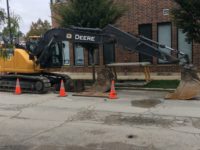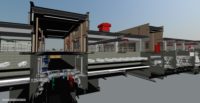
During the 19th century, Chicago’s sewage got dumped into the Chicago River and flowed into Lake Michigan. Because the city’s drinking water was, and still is, drawn from the lake via two mile-long tunnels, officials feared that the sewage would endanger the water supply.
The solution was the construction of the Chicago Sanitary and Ship Canal, which would send large amounts of lake water into the Chicago River, reversing its flow and sending the water into the Des Plaines River, which is part of the Mississippi River system. The 28-mile-long canal would be 202 ft wide and 24 ft deep.
ENR’s predecessor magazine Engineering News detailed the project in its June 2, 1892, edition.
The Chicago Drainage Board divided the work into 29 contracts and split the material to be excavated into two classes, rock and “glacial drift,” defined as “top soil, earth, muck, sand, gravel, clay, hardpan, boulders, fragmentary rock displaced from its original bed and any other material that overlies bed rock.” Construction kicked off in 1892.
Trouble arose the following year when one contractor disputed the designation of the material in their section and stopped work. “McArthur Brothers have now struck a substance hard and solid and apparently made up of conglomerated pebbles, gravel, sand and clay. It requires drilling and blasting, and the contractors demand ‘rock price,’” which was much higher. After deliberating, the chief engineer refused to change the classification or allow the contractors to withdraw.
Another contractor, Streeter & Kenefick, also quit work, “declaring that to excavate this hard conglomerate at the price they had bid meant financial ruin.” The board declared their contract forfeited, rebid it, and the winning bidder’s price was slightly lower than the original sum. The magazine’s account stated, “Apparently the tough conglomerate which has caused so much trouble in this work is not so tough as has been claimed; or, at least, it appears to have no terrors for these new contractors.”
In June 1893, 2,000 workers, mostly Polish Americans in quarries in Lemont and Romeo, Ill., near the canal, went on strike and were dismissed. The Poles looked for work, and the canal seemed to offer it. Many of the canal workers were Black. “Fired by bad whisky and by what they regarded as an infringement upon their rights, the discharged employees of Lemont and Romeo undertook to drive off the men at work on the canal, with the result that several men of the attacking party were killed.”
A wide variety of machines were used, depending on the material encountered. “On the two easterly sections of the canal, the material to be dredged was a stiff brick clay, sometimes mixed with loam and sandy soil.” Dipper dredges were used on those sections. Steam shovels were used on other sections to remove hard clay, cemented gravel and rock, which was then transported by conveyors to the spoil bank. Where drilling and blasting was done, the broken rock was loaded into carts by hand and conveyed by stationary cable inclines, Lidgerwood traveling cableways and Brown cantilever hoists.
The workforce peaked at 8,500. Excavation totaled 40 million cu ft of earth and rock, the largest earthmoving project accomplished in North America up to that time. It trained a generation of American engineers, many of whom later worked on the Panama Canal. The Chicago River project opened in 1900.
During the 1920s, the dilution method of sewage treatment offered by the canal proved inadequate for the growing Chicago metro area, and treatment plants were constructed. The Sanitary District of Chicago was renamed the Metropolitan Water Reclamation District of Greater Chicago in 1989. Operation of the canal was turned over to the U.S. Army Corps of Engineers in 1930.






Post a comment to this article
Report Abusive Comment